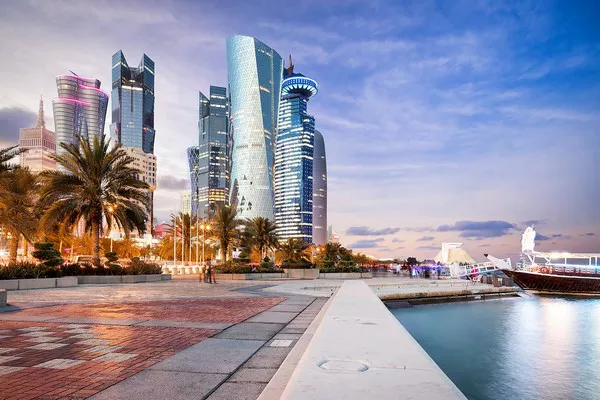In the dynamic landscape of global economics, certain nations stand out for their remarkable wealth, economic prowess, and high standards of living. The term “richest” encompasses various factors, including Gross Domestic Product (GDP), natural resources, and the overall well-being of the population. In this comprehensive exploration, we delve into the 10 richest countries in the world, shedding light on the economic factors that contribute to their prosperity and the unique characteristics that set them apart on the global stage. From financial powerhouses to resource-rich nations, these countries offer a glimpse into the multifaceted nature of wealth and affluence.
10 Richest Countries in the World
1. Qatar: A Wealthy Oasis in the Middle East
Economic Foundations
Nestled on the Arabian Peninsula, Qatar has emerged as one of the wealthiest countries globally, propelled by its vast reserves of natural gas. The nation’s strategic economic planning and investments in infrastructure and education have played pivotal roles in its prosperity. Qatar consistently ranks high in GDP per capita, reflecting the distribution of wealth among its relatively small population.
Diversification Efforts
Recognizing the importance of economic diversification, Qatar has embarked on initiatives to reduce its dependence on hydrocarbons. Investments in sectors such as finance, real estate, and technology aim to create a more sustainable and diversified economic landscape. The hosting of major events like the FIFA World Cup 2022 further positions Qatar as a global hub for business and tourism.
2. Luxembourg: A Financial Hub in the Heart of Europe
Financial Services Dominance
Nestled in the heart of Europe, Luxembourg is renowned for its robust financial sector, including banking and investment services. The country’s favorable tax policies and regulatory environment have attracted multinational corporations and financial institutions, contributing significantly to its economic prosperity. Luxembourg’s high GDP per capita reflects the affluence generated by its financial services industry.
Strategic Location
Luxembourg’s strategic location at the crossroads of Western Europe has facilitated international trade and commerce. The nation’s commitment to innovation and technology has further solidified its position as a key player in the European Union, contributing to its overall economic strength.
3. Singapore: The Lion City’s Economic Roar
Global Trading Hub
Singapore’s ascent to economic prominence can be attributed to its strategic location, efficient infrastructure, and commitment to open-market policies. As a global trading hub, Singapore has thrived on international trade and finance. The nation’s port is one of the busiest in the world, facilitating the flow of goods and capital. Singapore’s GDP per capita reflects its ability to translate economic activity into individual prosperity.
Innovation and Technology
Singapore’s focus on innovation and technology has propelled it into the ranks of the world’s wealthiest nations. The government’s investment in research and development, along with its emphasis on a knowledge-based economy, has attracted global businesses and talent. Singapore’s success as a smart city and technology hub positions it for sustained economic growth.
4. Brunei: Oil Wealth in Southeast Asia
Hydrocarbon Resources
Situated on the island of Borneo in Southeast Asia, Brunei is known for its significant reserves of oil and natural gas. The exploitation of these resources has been the primary driver of Brunei’s economic prosperity. The nation’s GDP per capita reflects the substantial wealth generated by its hydrocarbon sector.
Diversification Efforts
In recent years, Brunei has taken steps to diversify its economy and reduce dependence on oil and gas. Investments in sectors such as tourism, finance, and technology aim to create a more resilient economic foundation. Brunei’s commitment to sustainable development reflects a strategic approach to long-term economic stability.
5. Kuwait: Oil Riches on the Arabian Peninsula
Abundant Oil Reserves
Kuwait, situated on the Arabian Peninsula, is renowned for its abundant oil reserves, which have long been the cornerstone of its economic strength. The nation’s significant oil wealth has enabled investments in infrastructure, education, and social welfare, contributing to a high standard of living for its citizens.
Economic Diversification
In recognition of the need for economic diversification, Kuwait has undertaken initiatives to reduce reliance on oil revenues. Investments in sectors such as finance, real estate, and healthcare aim to create a more diversified and sustainable economic landscape. Kuwait’s position as a major oil exporter, however, remains a crucial factor in its overall prosperity.
6. United Arab Emirates: A Vision of Economic Success
Diverse Economy
Comprising seven emirates, including Dubai and Abu Dhabi, the United Arab Emirates (UAE) has achieved economic success through diversification and visionary leadership. The nation’s economy encompasses sectors such as tourism, real estate, finance, and technology. The UAE’s GDP per capita reflects the economic prosperity enjoyed by its population.
Strategic Investments
The UAE’s strategic investments in infrastructure, including state-of-the-art airports and futuristic urban developments, have positioned it as a global business and tourism hub. The nation’s commitment to innovation and sustainable development further underscores its role as a key player in the Middle East.
7. Switzerland: Financial Stewardship in the Heart of Europe
Financial Services Hub
Switzerland, nestled in the heart of Europe, is renowned for its stability, financial services, and high standard of living. The country’s banking sector, including private banking and wealth management, has attracted global clients, contributing to Switzerland’s economic prosperity. The GDP per capita reflects the nation’s ability to translate economic activities into individual wealth.
Innovation and Precision Manufacturing
Switzerland’s success extends beyond finance to innovation and precision manufacturing. The nation’s emphasis on research and development, as well as its engineering prowess, has solidified its position as a global leader in sectors such as pharmaceuticals, machinery, and watchmaking.
8. Norway: Natural Resources and Sustainable Development
Abundant Oil and Gas Resources
Norway’s economic success is closely tied to its abundant natural resources, particularly oil and gas. The nation’s sovereign wealth fund, fueled by oil revenues, is one of the largest in the world. Norway’s commitment to responsible and sustainable management of its resources has contributed to long-term economic stability.
Innovation and Social Welfare
In addition to its natural resource wealth, Norway’s commitment to innovation and social welfare has played a crucial role in its economic prosperity. Investments in education, healthcare, and technology have contributed to a high standard of living for its citizens. Norway’s balanced approach to economic development reflects a commitment to both prosperity and sustainability.
9. United States: Economic Powerhouse and Innovation Hub
Diverse Economy
As the world’s largest economy, the United States boasts a diverse economic landscape that includes finance, technology, manufacturing, and services. The nation’s GDP, driven by a large and dynamic population, reflects its economic prowess and global influence. The United States remains a magnet for talent, innovation, and investment.
Innovation and Technology Leadership
The United States is a global leader in innovation and technology. Silicon Valley, located in California, is synonymous with the tech industry and has fueled advancements in information technology, biotechnology, and renewable energy. The nation’s commitment to research and development positions it at the forefront of global innovation.
10. Saudi Arabia: Vision 2030 and Economic Transformation
Vision 2030 Reforms
Saudi Arabia, a key player in the Middle East, is undergoing transformative economic reforms as part of its Vision 2030 initiative. The nation, historically reliant on oil revenues, aims to diversify its economy through investments in sectors such as tourism, entertainment, and technology. Saudi Arabia’s strategic location and economic reforms contribute to its position among the world’s richest countries.
Investments in Infrastructure
Saudi Arabia’s investments in infrastructure projects, including the futuristic city of NEOM and entertainment destinations, underscore its commitment to economic diversification. The nation’s efforts to attract foreign investment and talent reflect a forward-looking approach to long-term economic sustainability.
See Also:TOP 10 MANGO PRODUCING COUNTRIES IN THE WORLD
Conclusion
The 10 richest countries in the world showcase the diverse paths nations can take to achieve economic prosperity. From hydrocarbon-rich nations to financial powerhouses and innovation hubs, these countries navigate the complexities of wealth and global dynamics. The challenges of sustaining prosperity, diversifying economies, and fostering inclusive growth are ongoing considerations for these nations.
As we explore the economic landscapes of these wealthy nations, it becomes clear that prosperity is not solely defined by GDP figures but is intricately linked to strategic planning, responsible resource management, and a commitment to innovation. The evolving nature of global economics ensures that these countries will continue to play pivotal roles in shaping the future of our interconnected world.
You Might Be Interested In:



























